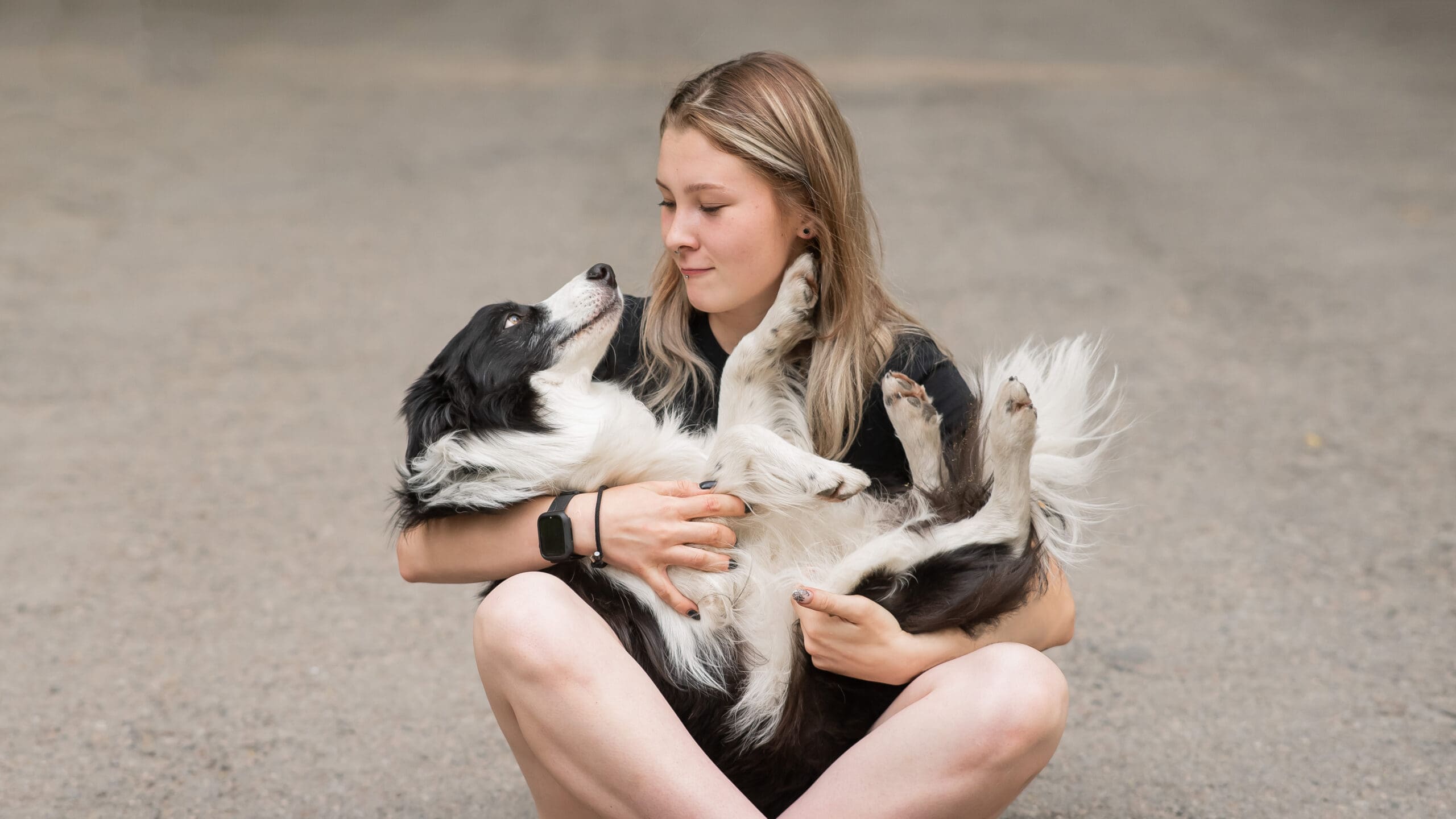If you are exploring support options for a mental health condition, you may have encountered many confusing terms like emotional support animals, therapy dogs, and service dogs. It can be hard to know the difference. This guide focuses on one specific and legally protected type of assistance animal: psychiatric service dogs (PSDs).
Unlike other support animals, a PSD is individually trained to perform tasks directly related to a person’s mental health disability. This guide explains exactly what psychiatric service dogs are, their role in managing mental health, the legal protections they have, and the steps involved in getting one.
What Are Psychiatric Service Dogs?
A psychiatric service dog (PSD) is a dog that is individually trained to perform specific tasks for a person with a mental health disability. This is the official definition according to the Americans with Disabilities Act (ADA). The most important part of that definition is “trained to perform tasks.” This is what sets a PSD apart from a pet or an emotional support animal.
PSDs are legally recognized service animals, just like guide dogs for the blind or mobility dogs for wheelchair users. Their role is to help handlers manage mental health conditions such as PTSD, severe anxiety, or depression. These dogs are working animals with an essential job: providing targeted support that enhances daily functioning and independence.
For a broader understanding of specific roles and responsibilities, consider reading our guide on the types of service dogs.
Psychiatric Service Dogs vs. Emotional Support Animals: Legal Differences
The terms psychiatric service dog (PSD) and emotional support animal (ESA) are often confused, but they are very different under the law. Knowing these differences is essential for understanding your rights.
Training and Tasks
A psychiatric service dog is individually trained to perform specific tasks that help manage a mental health disability. This could include applying deep pressure therapy during a panic attack, interrupting repetitive behaviors, or guiding a handler to a safe space.
In contrast, an emotional support animal does not require specialized task training. Its primary role is to provide comfort and companionship simply by being present.
Public Access Rights
PSDs have full public access under the Americans with Disabilities Act (ADA). They can accompany their handler into restaurants, stores, hotels, and other public spaces without restriction.
ESAs do not have these rights. Businesses and public spaces can legally deny entry to an ESA, as they are considered pets rather than working service animals.
Housing and Travel
Both PSDs and ESAs are protected under the Fair Housing Act, which requires landlords to make reasonable accommodations even in “no pets” housing.
However, only PSDs are guaranteed the right to fly in the cabin of an aircraft under the Air Carrier Access Act (ACAA). ESAs no longer have this privilege and must travel as pets.
While both PSDs and ESAs provide support, only psychiatric service dogs are legally recognized as working animals with specific task training and broad protections in public and travel settings. Knowing the distinction ensures you choose the right type of support animal and understand your legal rights fully.
What Specific Tasks Can Psychiatric Service Dogs Perform?
Psychiatric service dogs are trained to perform tasks that directly assist their handler in managing a mental health disability. It is crucial to understand that these tasks go beyond mere companionship. They actively help reduce symptoms and improve daily functioning. The exact training depends on the handler’s needs, but some tasks are commonly taught.
Managing Anxiety and Panic
A PSD can sense early signs of a panic attack or rising anxiety and respond immediately. This might include nudging, applying gentle pressure, or guiding the handler to a quiet, safe area. By interrupting overwhelming feelings, the dog helps the handler regain control and stay grounded.
Supporting Focus and Behavior
For individuals with compulsive or repetitive behaviors, a PSD can provide gentle interruption. Examples include nudging during nail-biting, redirecting attention during obsessive thoughts, or prompting a calming pause. These interventions prevent harmful patterns from escalating.
Practical Daily Assistance
Some PSDs help with routine tasks affected by mental health challenges. They may remind handlers to take medication, retrieve items like a phone during stressful moments, or wake someone from distressing nightmares.
Social and Environmental Support
PSDs can create personal space in crowded or triggering settings, alert the handler to approaching strangers, or guide them safely through overwhelming environments. They also provide subtle social cues that can ease anxiety during public interactions.
Emergency and Safety Tasks
Some PSDs are trained to recognize signs of emotional distress and alert others, fetch help during crises, or even trigger medical alert devices if needed.
Every task a psychiatric service dog performs is designed to enhance independence, safety, and emotional stability. By addressing specific mental health needs, PSDs give handlers reliable, hands-on support that improves quality of life far beyond what a companion animal alone can offer.
Top 5 Psychiatric Service Dogs
While any dog can be trained as a psychiatric service dog, certain breeds are often favored for their calm demeanor, intelligence, and reliability. Here are five breeds commonly chosen for PSD work:
Labrador Retrievers
Labs are friendly, adaptable, and eager to please, making them excellent for handlers who need consistent support in public or busy environments. Their gentle temperament helps reduce stress during anxiety episodes.
Golden Retrievers
Known for patience and loyalty, golden retrievers form strong bonds with their handlers. They are reliable in performing tasks like deep pressure therapy or interrupting repetitive behaviors.
Standard Poodles
Highly intelligent and hypoallergenic, standard poodles excel at learning complex tasks. Their calm focus makes them ideal for handlers with allergies or for those who require precise behavioral support.
German Shepherds
German shepherds combine intelligence with loyalty and attentiveness. They are especially good for tasks requiring concentration, such as guiding a handler to safety during disorientation or alerting to environmental triggers.
Border Collies
Renowned for their focus and problem-solving skills, border collies can learn advanced tasks quickly. They thrive with handlers who need highly responsive and energetic support throughout the day.
When choosing a PSD, consider the breed’s temperament, size, and energy level, but remember the individual dog’s personality is most important. The right match ensures your psychiatric service dog can provide consistent, dependable support tailored to your needs.
How to Qualify for a Psychiatric Service Dog
To qualify for a psychiatric service dog, a person must have a disability as defined by the ADA. This means having a mental health impairment that “substantially limits one or more major life activities.” These activities can include things like working, sleeping, socializing, or caring for oneself.
A licensed mental health professional, such as a psychiatrist, psychologist, or licensed therapist, must diagnose you with a qualifying condition. Some examples include:
- Post-Traumatic Stress Disorder (PTSD)
- Severe Anxiety Disorders
- Panic Disorder
- Major Depressive Disorder
- Bipolar Disorder
The critical factor is that the condition must be disabling, not just present. A formal diagnosis alone does not automatically qualify you. You need a professional assessment to determine whether your mental health challenges meet the legal standard for a disability and if a PSD would provide meaningful support as part of your treatment plan.
How to Get a Psychiatric Service Dog
Once you and your healthcare provider determine a PSD is right for you, there are several important steps to follow.
Step 1: Professional Consultation
Start with a licensed mental health professional who can provide an official diagnosis. This documentation may also be needed for housing accommodations or air travel.
Step 2: Finding the Right Dog
Not every dog is suited for service work. Look for a dog that is calm, intelligent, and not easily startled. You can adopt from a shelter or purchase from a reputable breeder who specializes in service dogs. If adopting, it is recommended to have a professional trainer evaluate the dog’s temperament first.
Step 3: Training the Dog
There are two main paths:
- Owner-Training: You train the dog yourself, often with guidance from a professional trainer. This requires dedication, consistency, and patience.
- Program-Trained Dogs: You can apply to an organization that provides fully trained PSDs. These dogs are ready to perform tasks but may involve long waiting lists and higher costs.
Regardless of the path, the dog must learn task-specific skills and public access behaviors. They must be well-behaved, housebroken, and under your control at all times. Positive reinforcement training is the most effective and humane method.
Need some help with registering? Check our in-depth service dog guide.


Choose the Right Fit from A Variety of Psychiatric Service Dogs
Getting a psychiatric service dog is a major life decision. It is a partnership that requires commitment, responsibility, and a deep bond. These animals provide security, independence, and hands-on support that can profoundly improve life for someone with a mental health disability.
A PSD can help you navigate crowded spaces, interrupt anxiety, or wake you from nightmares. The tasks they perform are tailored to your specific needs, making compatibility essential. When choosing a dog, consider its temperament, energy level, and responsiveness. Spend time with potential dogs and consult trainers or professionals to ensure a strong match.
By understanding your rights, the training process, and how each dog’s strengths align with your needs, you can select a PSD that not only supports your mental health but also becomes a reliable, loving companion for years to come.




